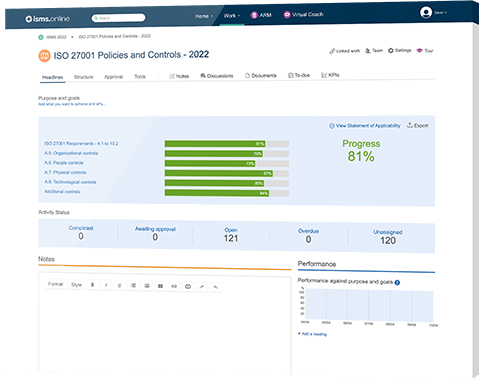
No computer network, system, piece of software or device is 100% secure. Vulnerabilities are part and parcel of running a modern LAN or WAN, and it’s important for organisations to acknowledge that firstly, they do exist, and secondly, the need to minimise risk where they have the potential to occur.
Control 8.8 contains a sizeable amount of advice that helps organisations to prevent the internal and external exploitation of vulnerabilities across their entire network. Control 8.8 relies on supporting procedures and guidelines from numerous other ISO 27002:2022 controls, particularly those that relate to change management (see Control 8.32) and access control protocols.
Control 8.8 is a preventative control that maintains risk by implementing procedures which gather information about technical vulnerabilities and allow the organisation to take appropriate measures to safeguard assets, systems, data and hardware.
| Control Type | Information Security Properties | Cybersecurity Concepts | Operational Capabilities | Security Domains |
|---|---|---|---|---|
| #Preventative | #Confidentiality #Integrity #Availability | #Identify #Protect | #Threat and Vulnerability Management | #Governance and Ecosystem #Protection #Defence |
Control 8.8 deals with the technical and administrative management of software, systems and ICT assets. Some of the guidelines involve deploying a highly-detailed approach to software management, asset management and network security auditing.
As such, ownership of Control 8.8 should reside with the individual who holds overall responsibility for maintaining the organisation’s ICT infrastructure, such as the Head of IT, or organisational equivalent.
Prior to implementing and vulnerability controls, it’s essential to obtain a complete and up-to-date list of physical and digital assets (see Controls 5.9 and 5.14) that are owned and operated by the organisation.
Software asset information should include:
When attempting to pinpoint technical vulnerabilities, organisations should:
In addition to internal systems, organisations should develop policies and procedures that detect vulnerabilities across all its products and services, and receive vulnerability assessments relating to the supply of said products and services.
ISO advises organisations to make a public effort to track down any vulnerabilities, and encourage third-parties to engage in vulnerability management efforts through the use of bounty programs (where exploits are looked for and reported to the organisation for a reward).
Organisations should make themselves available to the general public through forums, public email addresses and research activity so that the collective knowledge of the wider public can be used to safeguard products and services at source.
Where remedial action has been taken that affects users or customers, organisations should consider releasing relevant information to the affected individuals or organisations, and engage with specialist security organisations to disseminate information about vulnerabilities and attack vectors.
In addition, organisations should consider offering an automatic update procedure that customers are able to opt in or out of, based on their business needs.
Adequate reporting is key to ensuring swift and effective remedial action when vulnerabilities are discovered.
When evaluating vulnerabilities, organisations should:
Software vulnerabilities are best combated with a proactive approach to software updates and patch management.
Prior to any amendments being implemented, organisations should ensure that incumbent software versions are retained, all changes are fully tested and applied to a designated copy of the software.
When directly addressing vulnerabilities after they have been identified, organisations should:
In the event of an update not being available, or any issues that prevent an update being installed (such as cost issues), organisations should consider other measures, such as:

We’ll give you an 81% headstart
from the moment you log in
Book your demo
ISO 27002:2022-8.8 replaces two controls from ISO 27002:2013:
27002:2022-8.8 represents a fundamentally different approach to vulnerability management than is contained within 27002:2013.
27002:2013-12.6.1 is largely concerned with the implementation of remedial action once a vulnerability has been identified, whereas 18.2.3 is limited to technical tools (mostly penetration testing).
27002:2022-8.8 contains entirely new sections on topics such as an organisation’s public activities, how vulnerabilities are identified in the first place and the role that cloud providers play in ensuring vulnerabilities are kept to a minimum.
Overall, ISO places a larger emphasis on the role that vulnerability management plays in other areas of 27002:2022 (notably change management), and advocates for a holistic approach that draws in numerous other controls and information security procedures.
Our platform is intuitive and easy-to-use. It’s not just for highly technical people; it’s for everyone in your organisation. We encourage you to involve staff at all levels of your business in the process of building your ISMS, because that helps you to build a truly sustainable system.
Get in touch today to book a demo.
| ISO/IEC 27002:2022 Control Identifier | ISO/IEC 27002:2013 Control Identifier | Control Name |
|---|---|---|
| 5.7 | New | Threat intelligence |
| 5.23 | New | Information security for use of cloud services |
| 5.30 | New | ICT readiness for business continuity |
| 7.4 | New | Physical security monitoring |
| 8.9 | New | Configuration management |
| 8.10 | New | Information deletion |
| 8.11 | New | Data masking |
| 8.12 | New | Data leakage prevention |
| 8.16 | New | Monitoring activities |
| 8.23 | New | Web filtering |
| 8.28 | New | Secure coding |
| ISO/IEC 27002:2022 Control Identifier | ISO/IEC 27002:2013 Control Identifier | Control Name |
|---|---|---|
| 6.1 | 07.1.1 | Screening |
| 6.2 | 07.1.2 | Terms and conditions of employment |
| 6.3 | 07.2.2 | Information security awareness, education and training |
| 6.4 | 07.2.3 | Disciplinary process |
| 6.5 | 07.3.1 | Responsibilities after termination or change of employment |
| 6.6 | 13.2.4 | Confidentiality or non-disclosure agreements |
| 6.7 | 06.2.2 | Remote working |
| 6.8 | 16.1.2, 16.1.3 | Information security event reporting |
| ISO/IEC 27002:2022 Control Identifier | ISO/IEC 27002:2013 Control Identifier | Control Name |
|---|---|---|
| 7.1 | 11.1.1 | Physical security perimeters |
| 7.2 | 11.1.2, 11.1.6 | Physical entry |
| 7.3 | 11.1.3 | Securing offices, rooms and facilities |
| 7.4 | New | Physical security monitoring |
| 7.5 | 11.1.4 | Protecting against physical and environmental threats |
| 7.6 | 11.1.5 | Working in secure areas |
| 7.7 | 11.2.9 | Clear desk and clear screen |
| 7.8 | 11.2.1 | Equipment siting and protection |
| 7.9 | 11.2.6 | Security of assets off-premises |
| 7.10 | 08.3.1, 08.3.2, 08.3.3, 11.2.5 | Storage media |
| 7.11 | 11.2.2 | Supporting utilities |
| 7.12 | 11.2.3 | Cabling security |
| 7.13 | 11.2.4 | Equipment maintenance |
| 7.14 | 11.2.7 | Secure disposal or re-use of equipment |